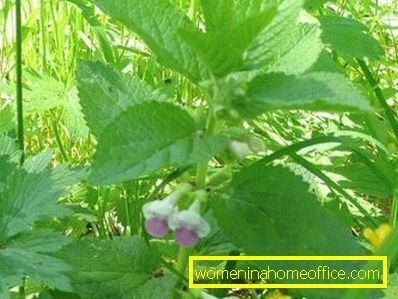Sarmatian censer - natural healer
Kadzila, balsam, balsan, fragrant Dubrovka, bee-kelnik, forest tobacco - this is how people call this natural healer. It will provide emergency assistance for diarrhea, it can be used as a diuretic and wound healing agent for treating abscesses in the mouth and throat. The cooled tea brewed from fresh flowers of the Sarmatian censer has a refreshing effect, similar to the effect of mint, stops colic and abdominal pain. In hot form, this tea acts as a diaphoretic.
Since ancient times, the practice of traditional medicine used tincture of Sarmatian censer herb for the treatment of gastric and duodenal ulcers, pain in the gastrointestinal tract, diseases of the liver, heart, and female diseases. The raw material of the censer is also used externally: wounds and ulcers heal it with tincture.
Help - Sarmatian censer
The Sarmatian censer is a perennial herb with a straight tetrahedral stem reaching a height of 25-50 cm and long strips descending to the ground. The leaves of the Sarmatian censer are located on the petioles, with a broad lamina, up to 10 cm in length and up to 5 cm in width, the margin at the leaves is large-sized. The flowers grow by 2-6 pieces in the axils of the upper leaves, the flowers are large - 3-4 cm in diameter, two-lipped, white-pink or lilac, with a tart honey aroma. The fruits of the Sarmatian censer are ovoid nuts, which are 3-4 mm long. The Sarmatian censer blooms in late May - early June. Seeds ripen in July.

Where to look for Sarmatian censer?
In the wild, the Sarmatian censer can be found in Central and Western Europe, as well as in the west of the European part of Russia. The censer grows in meadow-pine and hornbeam forests.
Growing censer Sarmatian
In nature, the Sarmatian censer is becoming increasingly rare, and therefore it will be more convenient for you to grow it yourself. For normal growth and development, the Sarmatian censer requires a fertile, nutrient-rich, structural, well-drained soil.
The plant propagates by seed or by dividing a bush. For sowing, it is necessary to plow the land to a depth of 25-30 cm, then apply organic and mineral fertilizers. Between rows it is necessary to keep a distance of 70 cm, in a row between plants - 20-30 cm. Sowing depth - 2-3 cm. Care will be made to keep the soil loose, regular weeding of the soil and annual fertilizing with fertilizers. With seed reproduction, the censer will bloom only in the second year of life, with vegetative reproduction (by dividing the bush) - in the first.
The buds will appear at the end of May, the active flowering of the plant will fall on the beginning of June and will last from 20 to 30 days. Seeds of censer ripen in late June - mid July. They need to be collected for several visits, as they are fully matured. The collected seeds should be sown immediately in the soil, as they will fall into deep dormancy during storage and their ability to germinate will drop dramatically.
Features of the collection of the Sarmatian censer
As the medicinal raw material, Sarmatian censer is used aboveground part of the plant (censer grass), cut off at a distance of 5-10 cm from the ground. The collection of raw materials should be carried out in the period of active flowering plants. The cut grass must be spread out in a thin layer on paper and dried on the street under a canopy, or in a regularly ventilated room. Drying time - 10 days. You can also prepare raw materials quickly, using the oven: spread out the grass in a thin layer on the sieve and dry at a temperature of 35-40 degrees. Keep the Sarmatian censer grass in bags or in tightly closed boxes, the shelf life of the raw material is 1 year.
- Contraindications: pregnancy, idiosyncrasy.
- Side effects No censer drugs have yet been identified.
Recipes treatment with Sarmatian censer
Infusion for the treatment of pustules and wounds
1 tablespoon of the crushed raw materials from the Sarmatian censer pour 1 cup of boiling water, leave for 30 minutes, then strain. Take 80 ml of infusion three times a day (before each meal). The course of treatment is from 2 weeks to 1 month. Infusion of the Sarmatian censer is an excellent wound-healing agent. Lotions with this infusion are particularly effective for the treatment of pustular skin diseases in patients with a diagnosis of diabetes mellitus.

Tincture for the stomach, liver and heart
10 g (1 tablespoon) of dry chopped herb censer Sarmatian pour 125 ml (0.5 cups) of vodka, leave for 2 weeks, then strain. Take 25-30 drops of tincture three times a day (after each meal). Tincture of the herb censer Sarmatian drink on vodka with gastric ulcer and duodenal ulcer, pain in the stomach, stomach. This infusion will also help in the treatment of pulmonary tuberculosis, colds, diseases of the liver, heart, female diseases, diarrhea. Outwardly, the tincture will help to heal erysipelas.
Tincture with honey against inflammatory processes
5 g (1 teaspoon) of fresh herb censer Sarmatian pour 500 ml of vodka and leave for 4-5 days, then strain and add 20 g (2 tablespoons) of honey. Take this tincture of 1 tablespoon in the morning and evening (before the first and before the last meal) to increase the appetite. The tincture also has anti-inflammatory and wound-healing properties, so you can drink it in courses for 7-14 days for ulcers, liver diseases, sore throat, and female diseases. Before starting treatment, be sure to consult with your doctor.
The Sarmatian censer raw material has a rather pleasant aroma and contains essential oil, flavonoids and coumarins, therefore, it is widely used for flavoring various beverages.
Especially for womeninahomeoffice.com.ru- Kseniya